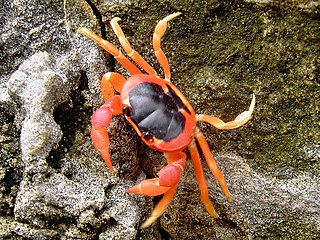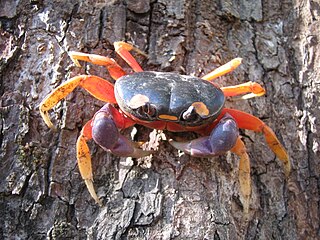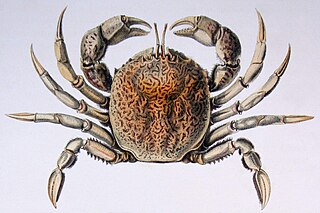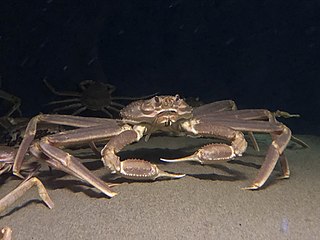
Malpelo is a small oceanic island in the eastern Pacific Ocean, located about 500 km (310 mi) west of the Colombian mainland with a military post manned by the Colombian Armed Forces. It consists of a sheer and barren rock with three high peaks, the highest being the 300 m (980 ft) Cerro de la Mona. The island is about 1.5 kilometres in length from northeast to southwest, and 640 metres across at its widest.

Ocypode is a genus of ghost crabs found in the sandy shores of tropical and subtropical regions throughout the world. They have a box-like body, thick and elongated eyestalks, and one claw is larger than the other in both males and females. They inhabit deep burrows in the intertidal zone. They are primarily nocturnal, and are generalist scavengers and predators of small animals. The genus contains 21 species.

Stenorhynchus seticornis, the yellowline arrow crab or simply arrow crab, is a species of marine crab.

Cancer is a genus of marine crabs in the family Cancridae. It includes eight extant species and three extinct species, including familiar crabs of the littoral zone, such as the European edible crab, the Jonah crab and the red rock crab. It is thought to have evolved from related genera in the Pacific Ocean in the Miocene.

Tuerkayana hirtipes is a species of terrestrial crab.

The Gecarcinidae, the land crabs, are a family of true crabs that are adapted for terrestrial existence. Similar to all other crabs, land crabs possess a series of gills. In addition, the part of the carapace covering the gills is inflated and equipped with blood vessels. These organs extract oxygen from the air, analogous to the vertebrate lungs. Adult land crabs are terrestrial, but visit the sea periodically, where they breed and their larvae develop. Land crabs are tropical omnivores which sometimes cause considerable damage to crops. Most land crabs have one of their claws larger than the other.

Gecarcinus lateralis, also known by the common names blackback land crab, Bermuda land crab, red land crab and moon crab, is a colourful crab from the family Gecarcinidae.

Gecarcinus is the type genus of the land crab family Gecarcinidae. They are found in warmer coastal regions of the Americas, including islands in the Caribbean. Four species from oceanic islands were formerly included in Gecarcinus as the subgenus Johngarthia, but are now treated as a separate genus, Johngarthia. While all members of this genus are largely terrestrial, they have to return to the ocean to breed. They are often colourful, with reddish, orange, purple, yellowish, whitish, or blackish being the dominating hues. This has resulted in some species, notably G. quadratus and G. lateralis, gaining a level of popularity in the pet trade.

Johngarthia is a genus of crabs in the land crab family Gecarcinidae, formerly included in the genus Gecarcinus, and containing six species. The genus bears the name of John S. Garth, a 20th century naturalist who specialized in crabs and other arthropods.

The coconut crab is a terrestrial species of giant hermit crab, and is also known as the robber crab or palm thief. It is the largest terrestrial arthropod known, with a weight of up to 4.1 kg (9 lb). The distance from the tip of one leg to the tip of another can be as wide as 1 m. It is found on islands across the Indian and Pacific Oceans, as far east as the Gambier Islands, Pitcairn Islands and Caroline Island and as far west as Zanzibar. While its range broadly shadows the distribution of the coconut palm, the coconut crab has been extirpated from most areas with a significant human population such as mainland Australia and Madagascar.

Bellia picta is a species of crab that lives around the coasts of South America, and the only species in the genus Bellia. On the Atlantic coast, it is found in Rio Grande do Sul, Brazil, while on the Pacific coast, it is found off Peru and Chile. It probably lives in burrows and is a filter feeder.
Johora singaporensis, the Singapore stream crab or Singapore freshwater crab, is a critically endangered species of freshwater crab endemic to Singapore. It grows to a size of 30 millimetres (1.2 in) wide.

Gecarcinus ruricola is a species of terrestrial crab. It is the most terrestrial of the Caribbean land crabs, and is found from western Cuba across the Antilles as far east as Barbados. Common names for G. ruricola include the purple land crab, black land crab, red land crab, and zombie crab.

Guinotia is a monotypic genus of freshwater crabs in the family Pseudothelphusidae, containing only the species Guinotia dentata, commonly known as cyrique. They have few predators. Found in the West Indies, they are easily caught and thus are used locally as a food source.

Johngarthia lagostoma is a species of terrestrial crab that lives on Ascension Island and three other islands in the South Atlantic. It grows to a carapace width of 110 mm (4.3 in) on Ascension Island, where it is the largest native land animal. It exists in two distinct colour morphs, one yellow and one purple, with few intermediates. The yellow morph dominates on Ascension Island, while the purple morph is more frequent on Rocas Atoll. The species differs from other Johngarthia species by the form of the third maxilliped.

Chionoecetes opilio, a species of snow crab, also known as opilio crab or opies, is a predominantly epifaunal crustacean native to shelf depths in the northwest Atlantic Ocean and north Pacific Ocean. It is a well-known commercial species of Chionoecetes, often caught with traps or by trawling. Seven species are in the genus Chionoecetes, all of which bear the name "snow crab". C. opilio is related to C. bairdi, commonly known as the tanner crab, and other crab species found in the cold, northern oceans.

Speocarcinus is a genus of crabs in the family Pseudorhombilidae, containing six extant species, one fossil species from the Late Miocene, one fossil species from the Eocene (Lutetian) and one fossil species from the Early Eocene (Ypresian):
Melybia thalamita is a species of crab in the family Xanthidae, the only species in the genus Melybia. It is found in the western Atlantic Ocean, from Florida and the Gulf of Mexico south to São Paulo, Brazil, at depths of 10–200 metres (33–656 ft).

Johngarthia planata is a bright orange species of land crab that lives on inshore islands and the continental mainland coast of the tropical and subtropical Pacific coast of the Americas, including the Gulf of California, Costa Rica, Colombia, and continental mainland beaches of Mexico. The crabs are omnivorous and feed on seaweed (algae), vegetation and sometimes carrion.

Johngarthia oceanica, also known as Clipperton crab, is a bright orange species of land crab that lives on Clipperton Island and on Socorro Island in the Revillagigedo Islands off Mexico in the tropical eastern Pacific. Prior to 2019, J. oceanica was considered part of J. planata, however a reexamination determined the land crabs on the oceanic islands to be a separate species. J. oceanica differs from J. planata in the shape of the mesial lobe of the infraorbital margin and the color of its carapace.




















